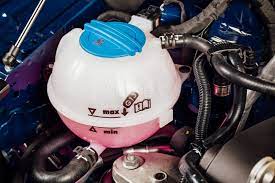
Checking your engine coolant is a safety measure and a car maintenance practice. The coolant system ensures your engine keeps running smooth and within the recommended hit levels.
The coolant prevents the car from overheating by absorbing heat from the engine and dissipating it through the radiator. In turn, the radiator absorbs this heat from the antifreeze fluid, directing to the atmosphere. Because of the coolant system, your car engine is able to operate at optimum temperatures. Another benefit of the coolant is that it prevents the engine parts from corroding.
How does the coolant look like?
Usually, the coolant is green in color. But also it can be red or blue in color. A colorless color or a rusty color means you should empty your contaminated coolant and replace it with uncontaminated coolant. Also, flush the coolant if you notice debris floating inside the coolant.
If you notice the coolant has a chocolate milk or sludgy look, the internal head gasket could be leaking oil. At this point, consider taking your car to a trained technician. This is not a repair you want to undertake by yourself.
How to check your engine coolant
Checking your coolant level is quite a straightforward procedure. Unless you will need to top up the coolant and flush the residue, you can take less than five minutes to check your coolant level.
-
Determine how hot the engine is
It is easy to tell the quantity of antifreeze fluid left in the coolant reservoir since the tank has markings for easier distinction. You only have to check the coolant reservoir to determine its level instead of opening the radiator cap. The heat from the radiator can be extremely hot.
N/B: Be sure to check the coolant level only when you have ascertained the car’s engine has cooled.
It is risky to add coolant to a steaming hot engine. Wait until the engine system has cooled as opening the caps can also cause leaks or serious scalding. You can place your hand on the car’s bonnet to feel if the hood is still hot or warm.
-
Locate the coolant reservoir
Now, to check the coolant level, locate the coolant reservoir tank, which is connected to the radiator, assuming you have lifted the hood of the car. The coolant reservoir is a white, plastic container. On this white container, inspect the quantity of fluid left inside. Check if the antifreeze fluid is below or above the recommended level. The reservoir tank can have a “MAX and “MIN” markings. Alternatively, it can have “LOW” and “FULL” markings inscribed on it.
You are good to go if the coolant level falls between “LOW” and “FULL” marks. If the coolant level reads as min or below the full mark, you will need to refill it.
-
Top up with the correct coolant
If you notice the coolant level is below the recommended mark, you need to refill it. As a rule of the thumb, the coolant should be a mix of 50 percent water and 50 percent coolant. You should only refill the coolant with water in emergency situations.
Also, note that some coolants come balanced with a ratio of 50/50. Be sure to check this when you want to top up your engine coolant with distilled water.
Now, to top up the coolant, unscrew the cap from the reservoir tank. Next, direct a funnel towards the opening, and pour your premixed coolant until the level reaches to desired heights. After that, screw back the reservoir cap and lock the hood.
Also, if the engine overheats a lot or you always find your coolant below the average level, it could be the coolant reservoir is failing. Before you top up the reservoir with coolant, be keen to note if you will observe such symptoms. Sometimes you may need to replace the coolant reservoir tank.
How often should you check your engine coolant?
Some people recommend checking the coolant after driving for after an average 30,000 miles. If you are unsure of this figure, make it a habit to check your coolant level occasionally, often between 24 and 36 months.
Next Read: Are You Taking Care Of your Engine Like You are Supposed To?


[…] Gasoline engines generate excess heat. Without an effective cooling system, the excess heat can cause the engine to fail. The cooling system ensures your car’s engine operates at optimal heat levels. At excess highs or low temperature wears off the engines’ components faster. Always ensure the cooling system is working effectively, and the coolant is within the recommended level. Checking the coolant level is straightforward procedure. […]
[…] Read: How To Check the Engine Coolant […]
[…] Gasoline engines generate excess heat. Without an effective cooling system, the excess heat can cause the engine to fail. The cooling system ensures your car’s engine operates at optimal heat levels. At excess highs or low temperature wears off the engines’ components faster. Always ensure the cooling system is working effectively, and the coolant is within the recommended level. Checking the coolant level is straightforward procedure. […]
[…] Read: How To Check the Engine Coolant […]